Hayao Miyazaki is a pillar of film, no matter how you look at it, and his accomplishments stand up to anyone in the medium, animated or live action. His Studio Ghibli films are one of the most important and revered cultural institutions of Japan, where he stands alongside and in equal stature to GODZILLA, who cuts a fairly imposing figure.
While he’s shamefully only won 1 Academy Award (for SPIRITED AWAY in 2001) and nominated for two others (THE WIND RISES and HOWL’S MOVING CASTLE), Miyazaki’s work has been universally beloved for decades. No director has a more consistently excellent reputation and track record (Studio Ghibli has proven more stable than even Pixar of late), and with THE WIND RISES, he finished on a high note, announcing his retirement from directing feature length films.
I’m no Miyazaki expert, and there’s an embarrassing number of his films that I haven’t seen, which is what I’m aiming to rectify in this forthcoming series. What follows is a trip down memory lane, and a journey through Miyazaki’s filmography, from his first, to the last.
LUPIN III: THE CASTLE OF CAGLIOSTRO (1979)
In 1967, Kazuhiko Kato created the comic book series LUPIN III under the incredible pen name of Monkey Punch. The manga creation about a sly playboy thief would sweep Japan, and lead to films, animated series, innumerable manga spin-offs, CD’s, video games, even a musical.
Perhaps the most famous of which was Hayao Miyazaki’s directorial debut, THE CASTLE OF CAGLIOSTRO, coming from a script written by Miyazaki and Haruya Yamazaki. The results are wacky, all over the place and pure bliss for a viewer.
Lupin (not Remus) and Jigen, his partner in crime (PIC), are up to no good, having stolen more money than you’ve ever seen from a casino and stuffed it in their cramped, but inexplicably resilient, yellow car. It’s dangerous how much money they have:
While driving, Lupin realizes the cash they stole is counterfeit, or “goat bills,” very good fakes. From this leap, it’s clear Lupin is an experienced burglar, and an expert driver. Instead of perhaps peddling the Monopoly money elsewhere, they empty the entire load while cruising on a bridge:
I feel like that would cause a lot of accidents/deaths.
Then, for no real reason, Lupin decides to drive to Cagliostro, the headquarters of the goat money. I guess he has another score in mind, and so they just drive. I’d have assumed that they originated in Japan, considering the creators behind the film, but Lupin is influenced by Arsene Lupin, a fictional French thief, so perhaps they were coming from the European continent after all. Either way, they quickly arrive at Cagliostro, a small and secluded island.
As far as I know Cagliostro is not a real place, so it’s presumably a fictional island, most likely off the coast of Italy. The Count Cagliostro may very well be fashioned after the enigmatic Alessandro Cagliostro, the alias of Giuseppe Balsamo, an Italian adventurer and occultist.
The gypsy man was even brought to life on celluloid previously, with a little help from…
When Lupin and Jigen arrive on the island, quickly they’re embroiled in one of the most ridiculous car chase scenes you’ll ever see, one that sets the tone for the entire madcap comic-book style adventure to come. Lupin and Jigen are driving aimlessly, until a runaway bride zooms by in another vehicle, clearly trying to make a break for it. A bunch of black people with nefarious mustaches are in pursuit (clearly all the same person/drawing), and Lupin, aiming for some tail, tries to save the woman.
In so doing, we learn that we’re entering a physics-altering reality, albeit an awesome one:
At one point, the bride is knocked out at the wheel, yet manages to stay in her lane on a winding road high up in the mountains for far too long. At another point, Lupin drives their car UP A COMPLETELY VERTICAL HILL (see below). It naturally ends with Lupin grasping the bride in his arms, dangling from a cliff, after using his utility belt and grappling hook. Lupin is Batman.
Princess Clarisse, the bride, justifiably freaks out when she wakes up to find herself being held by a stranger from great and terrifying heights. But, when more men arrive to capture Clarisse, they succeed, taking her away. But she accidentally left a ring with Lupin, one displaying the crest of her family and giving Lupin a new mission: to save Clarisse from the clutches of Count Cagliostro, who aims to unite two ancient families to uncover a storied treasure. A treasure that comes from within the awesome, beautiful, downtrodden Castle:
For the opening couple scenes, Lupin and Jigen appear to be on equal footing in their villainous partnership, both bickering with one another. Once at the Castle, Jigen and Goemon the samurai (who appears out of nowhere to lend a helping sword) have transitioned completely into sidekick/thankless side character.
At the Castle, we meet the Big Bad, the toad-faced Count Cagliostro, a creepy criminal mastermind in charge of the biggest counterfeiting operation in the world, forcing Clarisse to marry him. Naturally, he only speaks out of one side of his mouth (the evil side).
He’s like a French/Italian version of Shooter McGavin and Rob Lowe’s character in WAYNE’S WORLD, with a hint of pedophile for good measure. Plus, he wears a Ram mask:
He also has an absolutely terrifying butler/#2/Jeeves/Igor henchman in Jodo, some nightmarish Joker/Egghead hybrid. Somehow Jodo maintains absolute creeptastic levels, even though he constantly fails to corral and defeat Lupin:
Clarisse is your typical damsel in distress Princess, with a definite Rapunzel/Sleeping Beauty/locked away in the top tower vibe going on. She also has quite the crush on Lupin, her would-be savior. Turns out Lupin met her when she was a little girl…adding a disturbing layer to their relationship. Thankfully, Miyazaki doesn’t make it romantic.
Lupin’s task to rescue the princess and find the treasure isn’t easy, as Cagliostro has “more security than your average Count.” That means lasers, an intricate system of tunnels, waterways, trap doors, secret passages, catacombs filled with cadavers, peephole paintings and a confusing and needlessly extravagant set up of gears and springs and mechanisms befitting the inside of a watch somewhere underneath the castgle. This leads to many an awesome sequence within them.
The movie is loaded with slapstick thanks to perpetually red-faced Inspector Keibu Zenigata, a semi-hapless Interpol agent obsessed with tracking down and capturing Lupin. He’s so over the top, that the top is a dot to him. At one point he even says, “We don’t need you Orientals.” Nice.
The underrated MVP of the proceedings is Fujiko (above). With a name like that, she’s naturally white with blonde hair. She’s basically Black Widow, a sexy and badass spy working undercover trying to expose the Count’s dastardly deeds, until Lupin blows up her slow play in about 12 minutes. She saves his ass multiple times anyways, and clearly is the one who truly has Lupin’s heart.
CASTLE OF CAGLIOSTRO is filled with idiosyncracies, maybe mistakes, that make the movie even more enjoyable. Lupin and Figen’s car changes color at night. Same with Clarisse’s hair. It’s supposed to indicate a difference in lighting…but it’s a ridiculous transformation.
Lupin climbs to the top of a castle with his bare hands on multiple occasions, proof that the slits in between bricks and stone are big enough for an expert thief. More impressively, he also RUNS STRAIGHT DOWN A CASTLE and practically reaches Mach III in so doing, and jumps farther and with greater alacrity than Super Mario. There’s also a tremendous scene where he swims miraculously against a torrential current in a sequence that would make Aquaman jealous:
The movie fits A LOT OF PLOT in 102 minutes. Apparently, the Count’s family and his counterfeiting ring has been behind the Great Depression, Napoleon’s rise and practically every devastating event in history. Lupin gets shot (the one time out of a million shots that the villains hit anyone) and actually has amnesia for a time. 10 years previously, Lupin met Clarisse, her dog and some servant in Cagliostro. This was before her parents died in a fire that destroyed the castle. It’s a lot to keep up with. The Count has a cadre of bullet proof, armored freaky ninjas with metal spiked gloves, who also wear black KKK robes during the Count and Clarisse’s insane wedding.
The Inspector, stumbling upon one of the biggest criminal rings in the world’s history, seeks help from the UN to bust the Count, but it’s clear they’re either in on it, or unwilling to put forth the effort to catch him (or perhaps it’d cripple the European economy). This leads to one of the best lines of cinematic history, when a UN adviser frustratingly points out: “We have a sticky widget here.” Indeed.
The Count also has some seriously rape-y lines, like when he promises Fujiko that “I’ll interrogate you in my chambers later!” He also threatens the ratings system, like when he yells, “Don’t move you meddling bitch!” Whoa now.
While rough around the edges, with some dated touches and lines that remind you of what your racist Great Uncle will say after a couple PBR’s at a barbecue, THE CASTLE OF CAGLIOSTRO is a delightful romp, with whispers of the beautifully simple and elegant animation style characteristic of a Miyazaki film, and a story with heart and humor. It’s more reliant on a standard villain and action than what will become Miyazaki’s calling card, and it’s far from subtle. The silly, saccharine sweet ending shows Miyazaki’s true colors. It also likely rubbed Monkey Punch fans the wrong way, as Lupin is typically portrayed as far more of a cynical playboy than what he turns out to be in this film.
After saving her bacon, Clarisse tries to go for the kiss, but Lupin turns away, instead kissing her on the cheek, telling her “she just got into the light;” you “don’t want to go into the darkness” by saddling up with a “ne’er do well like me.” I feel like if you call yourself a “ne’er do well,” you lose your street cred, but it’s another hilarious moment in this gleefully on-the-nose film.
When Lupin laughably/adorably points out that he has indeed secured a “precious and priceless” treasure, and he’s referring to Clarisse’s heart, it’s hard not to snort. But even so, CASTLE OF CAGLIOSTRO is the first step in Miyazaki’s journey into becoming a precious and priceless treasure to all who have seen his films.
Let me leave you with another classic moment, in which Lupin becomes a rocket ship, landing neatly in their speeding vehicle, his pants burning up in the process:
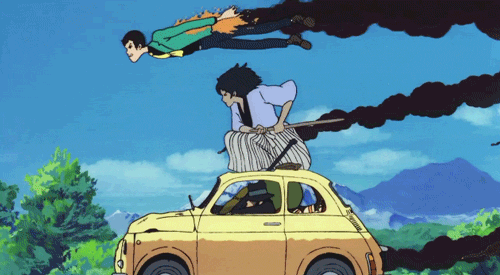



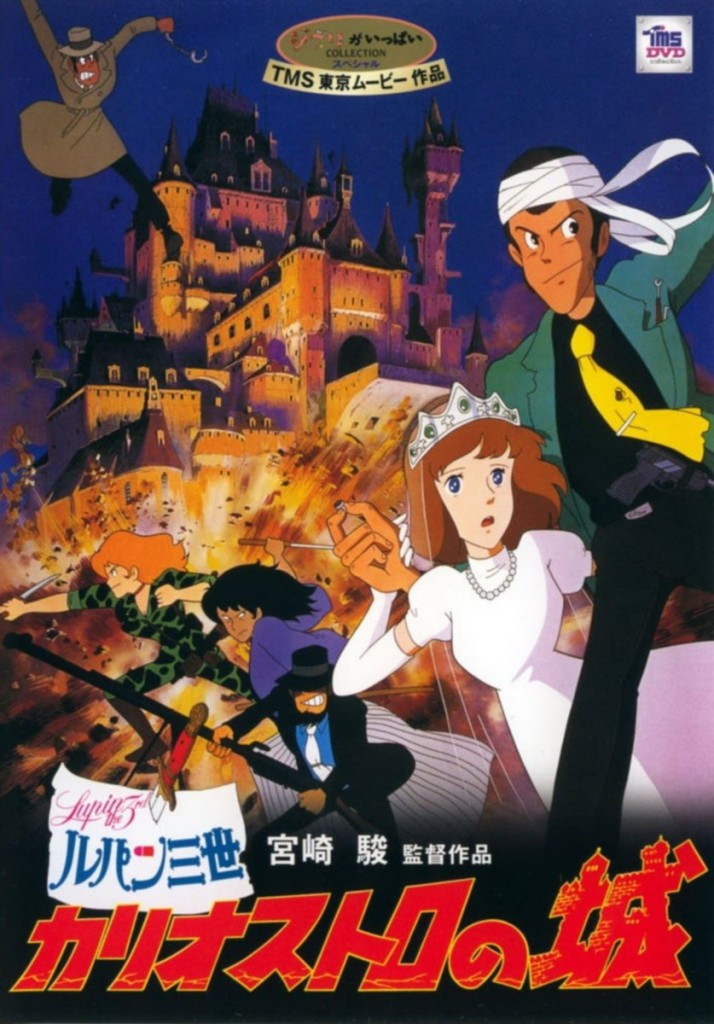
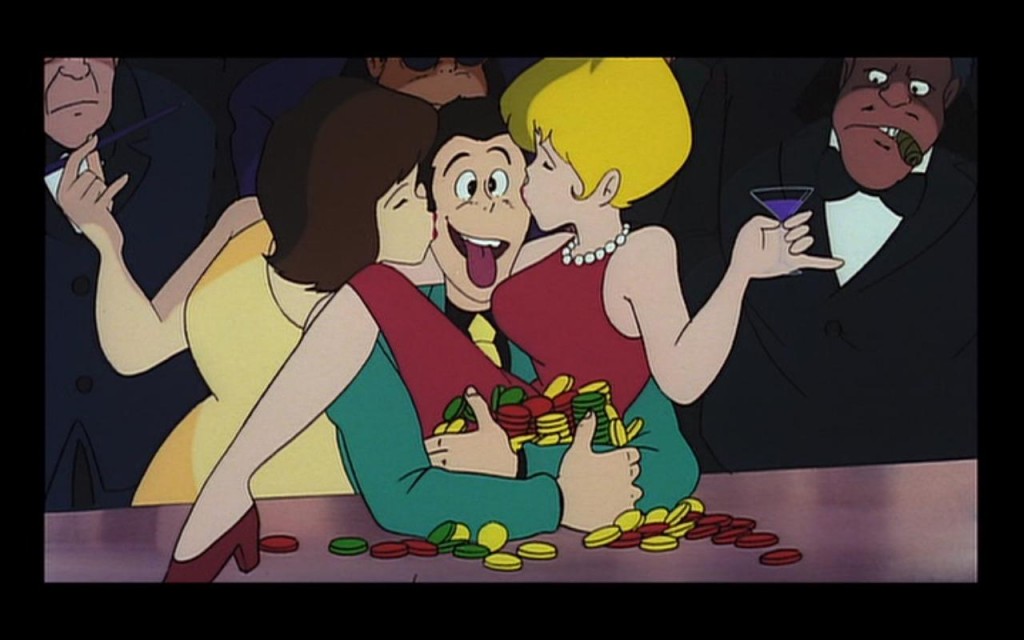
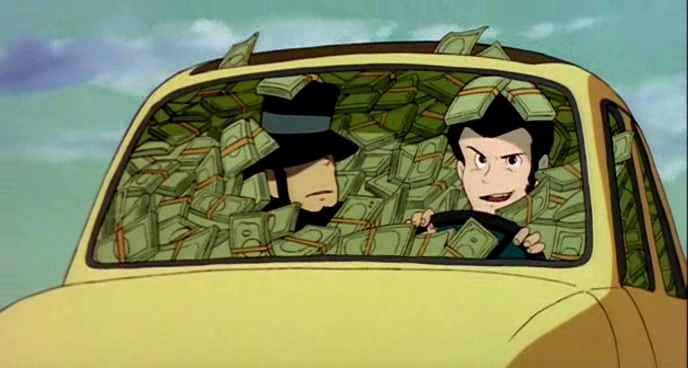

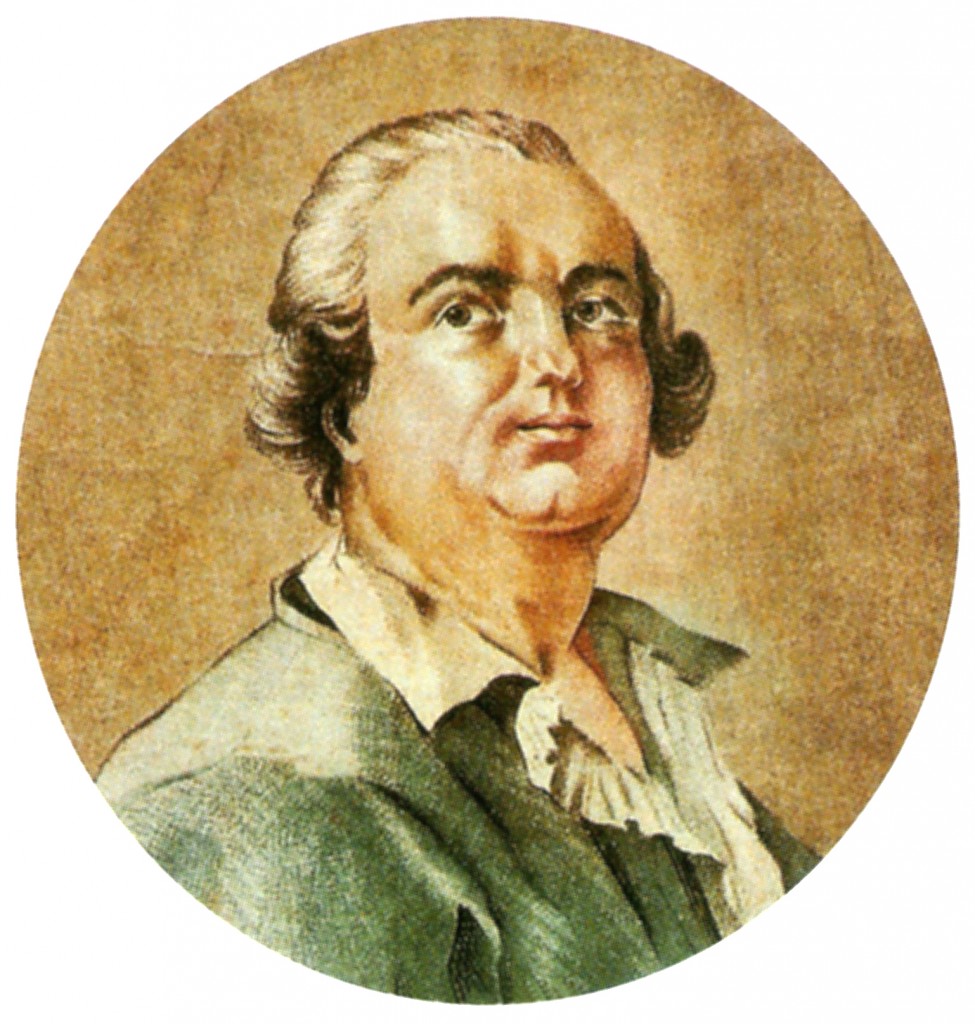
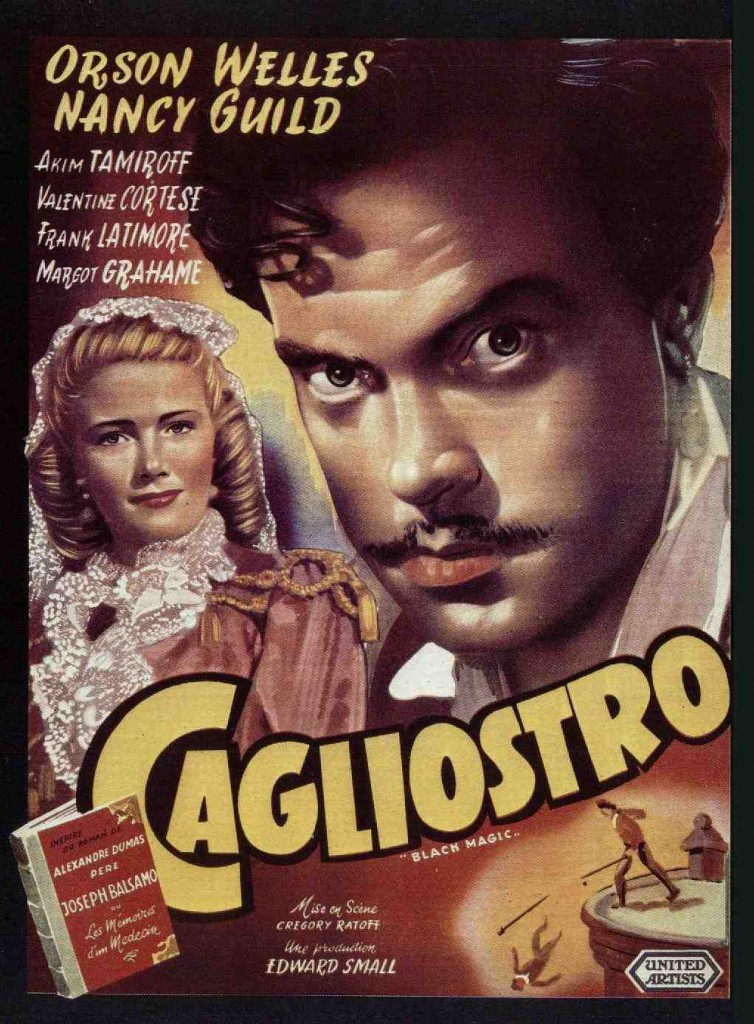
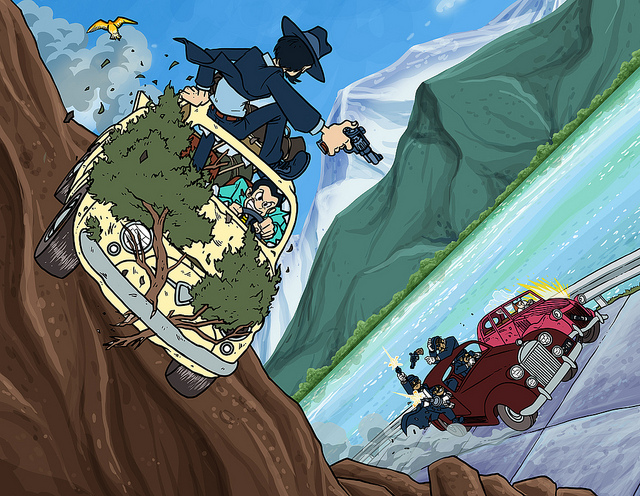

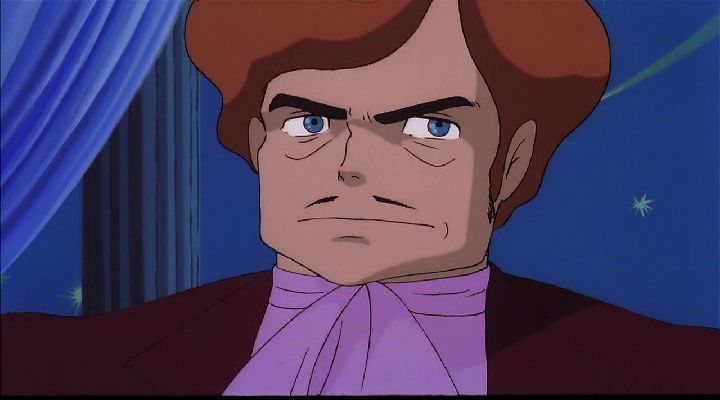

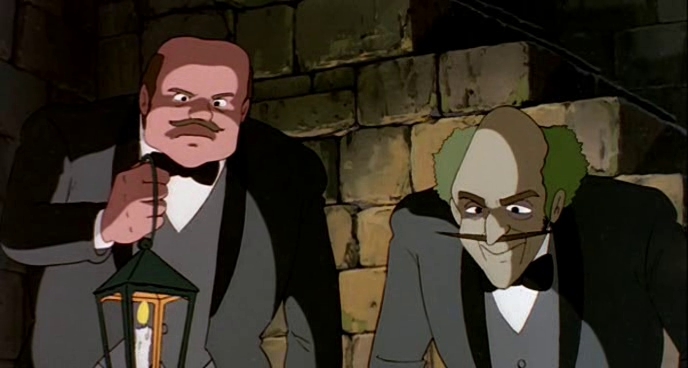
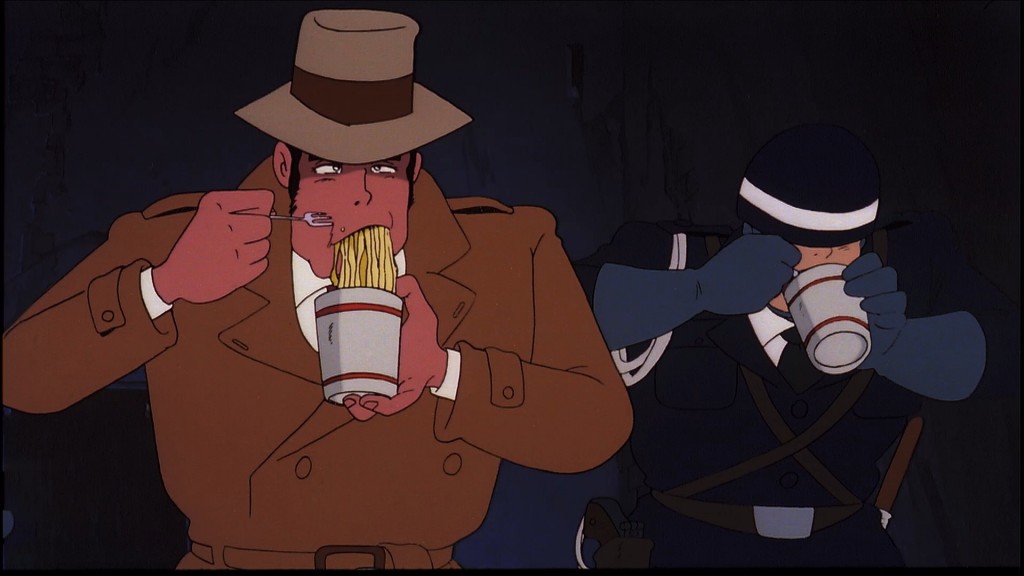
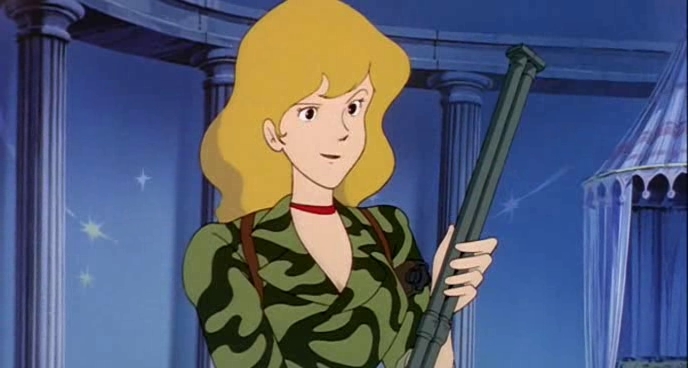
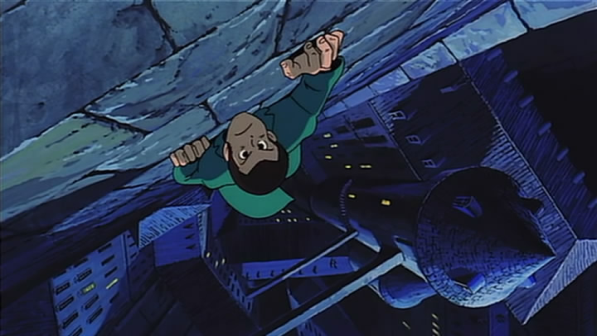
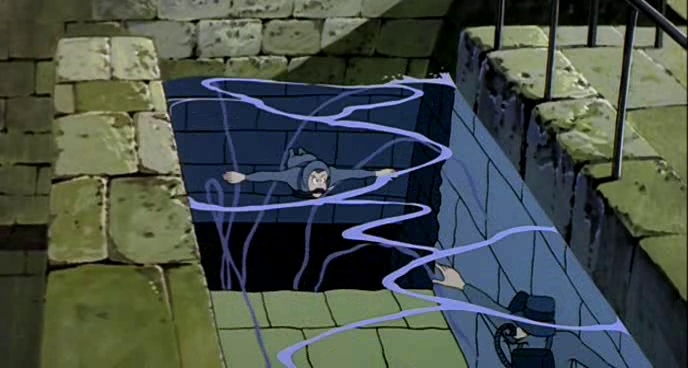
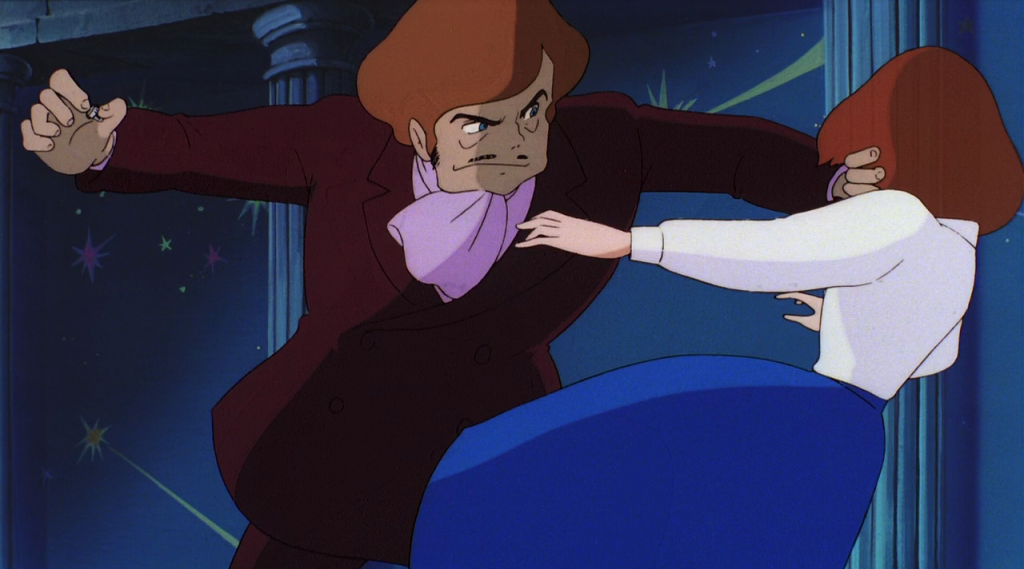
Pingback: LA EigaFest 2014: “Lupin The Third” - Seven Inches of Your Time
Pingback: LA EigaFest 2014: "Lupin The Third" Review | Pop Insomniacs
Pingback: No More Miyazaki? No Problem: Enchanting Irish Folklore Tale “Song of the Sea” Is Beacon Of Hope - Seven Inches of Your Time